
Accueil > Les rubriques > Images > Fading out traces
Fading out traces
The art of Marco Vaglieri between image and experience
, et
Toutes les versions de cet article : [English] [italiano]
Texts, actions, videos, happenings and ethical commitment : in its seventh appointment Las Italias faces Marco Vaglieri.
A very thin border stands between different artistic expressions. A border that has been subject of objections since the Total Artwork (Gesamtkunstwerk) and that has been dissolving during the Twentieth century, along a path which never ends, since it finds its meaning in its constant evolution.
Marco Vaglieri seems amused by constantly crossing it in his works, with an at the same time playful and thoughtful spirit.
Born in Milan in 1959, during his formative years Vaglieri breathes the passionate atmosphere of the Seventies, divided between the pulsating legacy of the avant-garde and the projection towards the most innovative European culture.
His first artworks, which were created in the early Nineties, show a progressive intolerance towards a cultural climate that seems to have lost its shine, and the research of alternative models for the circulation of art, which may provide a contact with public freed from mediation and out of galleries and institutional spaces.
His analysis looks for the answers which the artistic and cultural system fails to give in the society, and – as he declares - wants to create « extraordinary moments into the ordinary everyday reality, moments that may give back the artwork its lost aura ».
This Insieme fate cose pericolose Together you do dangerous things (in collaboration with Francesco Voltolina, Milan, 1993) gives birth to a happening in which visitors defines positions and postures for the bystanders. The operation is repeated in schools, gyms, fairs, festivals, psychiatric hospitals, galleries and it was documented by photographs.
It is difficult to interpret this action from a purely aestethic point of view, because it focuses its attention on ordinary actions, on a dimension that does not transcend and does not enchant, but it is accessible to anyone for its everyday aspect.

- Insieme fate cose pericolose/Together you do dangerous things, in collaborazione con/in collaboration with Francesco Voltolina, 1993, Cibachrome, cm 47x75, 1994, Milano
Along the same line, we find Operazioni necessarie alla circolazione accelerata di ossigeno Necessary operations for the accelerated circulation of oxygen (Milan, 1995) an operation in which the artist invites pedestrians to a have cup of tea with him in each of the three prefabricated toy houses with chairs and stove he built in different places of the city.

- Operazioni necessarie alla circolazione accelerata di ossigeno - Necessary operations for the accelerated circulation of oxygen, Stampa fotografica su polystyrene/photographic print on polystyrene, cm 100 x 320, 1995, Cusano Milanino (Milano)
The interaction, documented by five non-professional photographers, shows the connection with the Relational aesthetics and the neo-dada spirit of Fluxus and combines it with a clear inspiration to the situationist mold, which finds the true nature of the work in the game and in the involvement of pedestrians in an at the same time every day and unusual condition.

- Operazioni necessarie alla circolazione accelerata di ossigeno - Necessary operations for the accelerated circulation of oxygen, Stampa fotografica su polystyrene/photographic print on polystyrene, cm 100 x 320, 1995, Cusano Milanino (Milano)
The research of a reaction from a random public returns in Prendersi careico delle immagini (Taking on the responsibility of images - Iseo, Province of Brescia, 1995), an action composed by different moments : first a motorbike ride, during which the artist carries around a clearly visible photo print, that is documented by a video. Then, some people who saw the travelling image are interviewed.
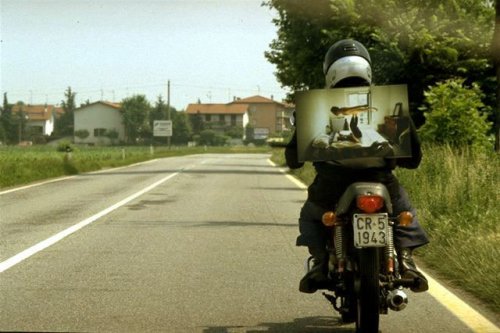
- Prendersi carico delle immagini - Taking care of images, Motocicletta, stampa fotografica su forex, libro di viaggio/ Motorcycle, photographic print on forex, travel book, 1995, Iseo (Brescia)
The action / situation finds its balance in the tripartite time dimension : the journey of the image, the interviews after its vision, the video which recollects all in a potentially infinite loop, all of them elements which challenge the idea of a single language of the art discipline.

- Prendersi carico delle immagini - Taking care of images, Stampa fotografica su forex/photographic print on forex, 1995, Iseo (Brescia)
According to Vaglieri, categories and terms of contemporary art are not enough : words such as photography, installation, image all fail to describe or to fully convey what he achieves. Process, task, action -which normally only lap the field of art- are much more suitable to describe it, to get its essence.
And, even if the artistic object is fully recognizable -like a video, a photograph- it often takes on a relative value compared with the conceptual sphere within which each operation is processed, the object becomes almost a simple trace of it along a continuous fading art border.
As an artist, Vaglieri seems to escape form the classification of art, but naturally, without forcing it, because -as he stated : "Regarding to the art I keep living a sense of hospitality. I do not feel exactly a precise identity. [...] I’m just a guest. The things I do are attributed to art. That is fine1".
You don’t fail to find gentle fathers of his art -as the above mentioned Fluxus and the Situazionist International- but Vaglieri’s line of research follows an independent path, which leads his analysis invariably outside the artistic field, towards the contact with other humans, toward a sense of belonging or community with other people’s lives.

- Abbracci/Hugs, Stampa trasferita elettrostaticamente/electrostatically transfered print, dimensioni variabili,1996
A contact that sometimes is declined in a physical meaning, as in the series Abbracci - Hugs (Milan, 1996), documented by photographs and a video where the artist stops passers-by in the streets to offer hugs ; other times it can be pushed on an intellectual and creative plane, as in Links, (Bologna 1996) a real time installation (with Eva Marisaldi and Francesco Voltolina) in which two tents -an inaccessible one, and the other available to the visitors- are connected by an audio system.
The opportunity to communicate (a tent speaks and the other listens in turn) establishes a dialogue between authors and visitors or builds a story founded on imagination.

- Links, in collaborazione con/in collaboration with Eva Marisaldi e/and Francesco Voltolina, Tenda da campo, istallazione audio, polystyrene/Camping tent, voice installation, polystyrene, 1996, Bologna
However, Vaglieri’s contact is not always a physical or a direct one. It can also become an action that the audience executes far from the "stage" of art and its creator, as in Ora ma non qui - Now but not here (Bologna, 1998) an operation in which the artist gives money to the viewers to let them go to “have pleasure”, which means to seek pleasure, fun, satisfaction or gratification of appetites, desires and aspirations.

- Ora ma non qui (Now but not here), 1998
The "documentation" of such recreational actions, which the audience chooses freely for itself, that consists of photos, audio recordings, texts, letters, it is then sent to journalists so that they may extract some articles which are laying out in the style of the publications they write for, as in Ora ma non qui (Gioia, pagate per divertirsi) Now but not here (Joy : Paid to have fun) (1999).
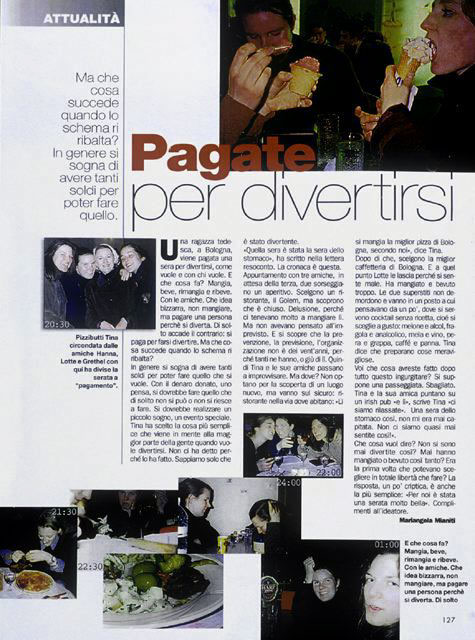
- Ora ma non qui (Gioia : Pagate per divertirsi) - Now but not here (Gioia : Paid to have fun), Laser print, cm 160x120, 1999
On the same path stands Una circostanza (Paura di me) - A circumstance (Fear of myself) (Milan, 1999), which is a reflection upon the urban fabric as a field of artistic intervention, and in which the audience is invited to spend time in a hotel room booked by the artist.
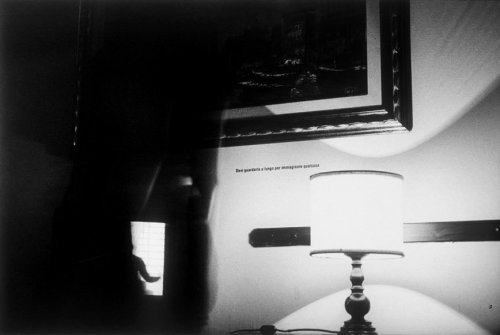
- Una circostanza (Devi guardare a lungo per immaginare qualcosa) - A circumstance (You must look for a long time to imagine something), Fotografia in bianco e nero/Black/white photography, cm 31x40, 1999, Milano
Even in this case, the action the artist performed tends to overrule the mode of creation and enjoyment of art : the actions related to the creative process are delegated to the public, which becomes itself a work of art being present in the room. The artist only provides the tools to create it.

- Una circostanza (Paura di me) - A circumstance (Fear of myself), Fotografia in bianco e nero/Black/white photography, cm 31x40, 1999
The audience could also receive the responsibility to create an object whose belonging to the world of art is recognized according to Duchamp’s ideas, as in the case of Imporsi, superare, trattenersi, sopravvivere... - Imposing oneself, to excel, restraining oneself , surviving ... (San Gimignano, Siena, 1999), where it was submitted to a survey.
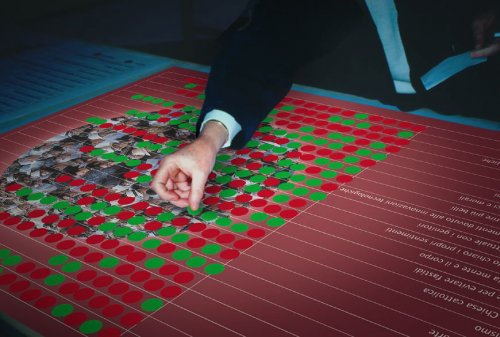
- Imporsi, superare, trattenersi, sopravvivere..., Imposing oneself, to excel, restraining oneself, surviving..., lambda print, tavoli, etichette adesive colorate/lambda print, tables, adhesive colour labels, 6 elementida cm /6 elements each of cm 100x140x75, 1999
The visitors affix a stamp (green as positive, red as against) to the panels where more than a hundred questions about different social behaviors were written, expressing this way their own point of view.

- Imporsi, superare, trattenersi, sopravvivere..., Imposing oneself, to excel, restraining oneself, surviving..., lambda print, tavoli, etichette adesive colorate/lambda print, tables, adhesive colour labels, 6 elementi da cm /6 elements each of cm 100x140x75, 1999
This way, all the visitors indicate, in fact, the orientation of the community that attends the exhibition space. The relational nature of the work and the differences of the results which can be obtained in various locations pinpoint the attention not only on the active role of the visitor, but also on the uniqueness of the artistic event.

- Esercizi di cognizione orizzontale - Horizontal exercises of cognizance - (o te ne tiri fuori o affini le armi/either you will pull you out or you sharpen your knife), Lambda print, cm 70x100, 1999, Torino
This kind of circumstances can be found in Esercizi di cognizione orizzontale - Horizontal exercises of cognizance (Turin, 1999), whose process is made of a series of questions about personal experiences the artist answers to some people he duly selected. The dialogue that emerges from that finds a summary in a single motto, drawn up by common agreement between the artist and his interlocutor, which is imprinted on a self-portrait which ideally sets the instant of the dialogue solution.
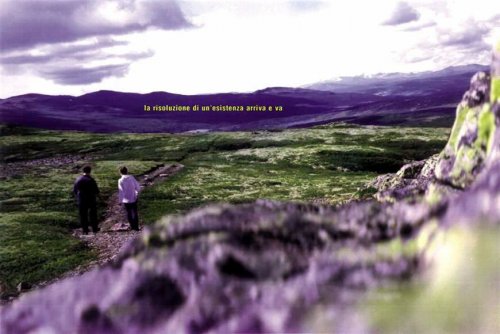
- Esercizi di cognizione orizzontale - (Horizontal exercises of cognizance) – La risoluzione di un’esistenza arriva e va – The resolution of an existence comes and goes, Lambda print, cm 70x100, 1999
This is how they arise : Qual è il posto della mitezza nel mondo ? (What is the place of gentleness in the world ?) for which the motto is O te ne tiri fuori o affili le armi (You pull it out or sharpen weapons), or Arriva il giorno in cui si può definire risolta un’esistenza ? (Is there a day when you can define an existence as settled ?) for which is La risoluzione di un’esistenza arriva e va (The resolution of a life comes and goes) and Non comunicare è possibile ? (Is it possible not to communicate ?) for which is Cerca di stare in silenzio con qualcuno (Try to stay silent with someone).

- Esercizi di cognizione orizzontale - (Horizontal exercises of cognizance) – Prova a stare in silenzio con qualcuno – Try to keep silent with someone, Lambda print, cm 70x100, 1999
A psychological journey, a commonality and a proximity which involves both speakers into play, in order to obtain an image that -this time- is not configured as documentation of the action, but as an object itself, or as an accomplished manifestation of the art work and -in same moment- as the process that created it.
The study of a specific issue through the dialogue can be found in Following John (Milan, 2002), a video which documents a conversation between Vaglieri and John Hemingway, a grandson of Ernst, during a bicycle training.
The inspiration offered by the famous grandfather of the interviewee becomes a pretext to deepen first the figure of John, who is a writer himself and, along the development of the dialogue, let one reflects on life and the legacy of family and cultural conditioning.

- Following John, Video, colour, sound Betacam, 00:12:00, 2000
Photography as a stand-alone element resumes in Allora (Then – Torino, 2001), a wall poster exhibited in the nearby of the Fiat Mirafiori, composed by a photo of the early 60s coming from the archive of the automotive company and a contemporary statement by Ennio Flaiano.
The economy cars whizzing by on the test track, which are a symbol of the optimism of the economic boom but also a prophecy of the forthcoming massification, produce an alienating effect combined with the words of the Abruzzese intellectual « Then I told him : look Agnelli, you can make how many cars you want, in any case I do not have a driver’s license ».
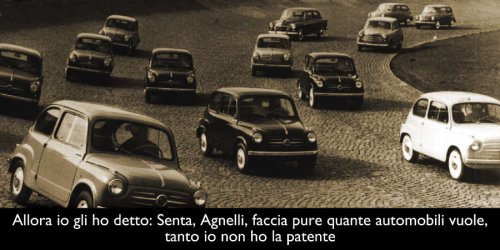
- Allora - (Then), Stampa in quadricromia su stoffa vinilica/Four-colour process on vinyl fabric, cm 315x600, 2001
The advertising language is forced to a sarcastic message, expressing an opposition, which -implied in the previous works- becomes gradually more and more explicit.
As in Jamais-Toujours (Never-everyday – Paris, 2009) an action done in collaboration with Marianne Heier, in Rue de Seine, where the artist takes up (and upsets down) the famous words written by Guy Debord in the same place in 1953 (Ne travaillez jamais).
The “never work”, replaced for five days by “we always work” is not only a tribute to the Situationist International dedication, but also an invitation to rethink in nowadays terms the artistic and political commitment. The disruptive message of Situationism, aimed to recovering a creative dimension of existence, as it is freed from the shackles of the bourgeois compulsion, it has changed over time the identity of a depersonalized cliché, swallowed up and distorted by the same society that it sought to dismember. The artist opposes this a long-continued effort and a daily commitment to find new forms of resistance to the "system."
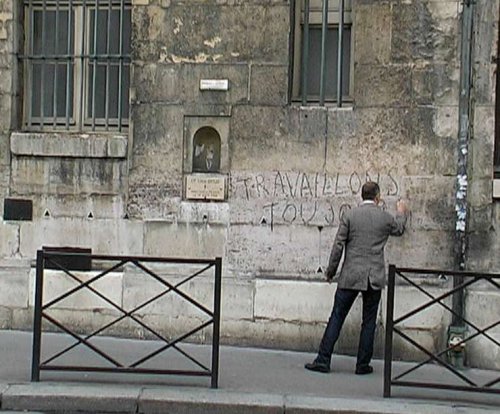
- Jamais Tojours, operazione in collaborazione con/operation in collaboration with Marianne Heier, 2009 Parigi/Paris
The combination between word, which has always played a key role in the operations of Vaglieri, and the aspect of the action and of the happening finds a summary in Il tempo che serve (The time that is needed – Turin, 2002), an exhibition consisting of two videos (divided into part I and part III) that give the exhibition its title, a series of photographic images gathered in Le Sette Svolte (The seven turning points) and of a series of watercolors entitled Storyboard, which -overtly preparatory for another video, The time is needed part II - provides a starting point for an intrusion into painting.
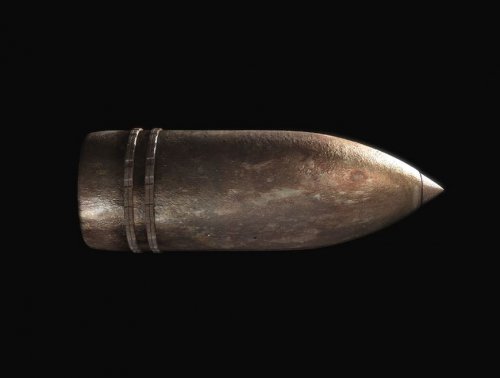
- Il tempo che serve (parte prima)/The time that is needed (first part)), Video, colour, sound, MiniDV, loop, 2002
The time that is needed (first part) is built around a single image -a hypnotic rusty howitzer wheeling on itself into the void- on which a feminine narrator’s voice, a personification of a soldier in some war, tells her memories and her reflections on the war, waiting for the inexorable tragedy to come.

- Il tempo che serve (parte terza) - The time that serves (third part), Video, colour, sound, Betacam, 00:14:00, 2002
The text is based on essays and historical memoirs of the First World War and is in contrast to Il tempo che serve (parte terza) - The Time That Is needed (third part), in which the artist -almost always a silhouette against the backdrop of a pristine landscape- goes around the battlefields of the Great War.
Abandoned trenches, shrines, military cemeteries and old images are the starting point for a reflection on the recent past and on the nature of conflicts, conducted with a lyrical tone.

- Le sette svolte,(The seven turning-points), Stampa fotografica e testo/Photographic print and text, 7 dittici ciascuno da cm/7 diptychs each of cm 40x26, 2002
The watercolors of Storyboard and the photographic images of Le Sette svolte (the seven turning points) should be considered complementary to the video. The latters, gathered in diptychs, depict objects of war as lunchboxes, helmets, and splinters, immersed in nature, associated with poems written by the artist.
The title refers to the seven days of the biblical creation, gradually chanting the concept of loss : of love, of family, of one selves and of God.

- Le sette svolte,(The seven turning-points), Stampa fotografica e testo/Photographic print and text, 7 dittici ciascuno da cm/7 diptychs each of cm 40x26, 2002
Contamination between the genres gives rise to the theatrical dimension of the work, as underlined by the recent Metafisica della carne (Metaphysics of the flesh - Milan 2008), a play written and performed by the artist in an art gallery that traces some Gospel episodes in a surreal tone and a laical key.

- Metafisica della carne - Metaphysics of flesh, pièce teatrale/theatre pièce, 2008
Vaglieri’s art is complex and encompasses the more different subjects and techniques, always staying in balance between creation and sharing : even if he feels like a "guest" in the world of art, he has a very clear vision of coherence and rigor needed to be an artist, and of the strength of the arts community.
In February 2014 a group of artists (Libia Castro, Ólafur Ólafsson, Charlie Sofo, Gabrielle de Vietri, Ahmet Öğüt) withdrew their works from the 19th Biennale of Sydney to protest against one of the main sponsors, the Transfield Holdings, which owns some shares of the company (the Transfield Services) that manages on behalf of the Australian government the detention centers for migrants in Manus Island and Nauru, where human rights violations are suspected following the death of a young Iranian who requested asylum.
The refusal position taken by the artists, according to Vaglieri, highlights : « As the potentates of art, often supported by dirty money, can be challenged. These artists did that, renewing in me the desire to feel part of a community that does not think only to personal success but which has a conscience ».
Voir en ligne : Website for Marco Vaglieri
1 G. Bertolino, Intervista in A. Pioselli, Marco Vaglieri, Luigi Franco ed., catalogo della mostra, Torino 1999, pg. 12
Aknowledgments :
Antonella Opera for supervision of English translation
